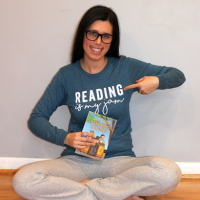

BLOGS > AUGUST 29, 2023
BY BRYNN ALLISON

The most important thing to consider when organizing your classroom library, whether you have 100 books or 1,000, is what is going to work best for you and your students. The organization of your classroom library should be manageable, sustainable, and help your students find books they are interested in reading.
If you are just starting out with your classroom library or if you are looking to overhaul its current organization system (or lack of), your first step should be to decide on your overall organizational method. Your options are to
Organizing books alphabetically by author’s last name is similar to how public libraries and bookstores are organized. If you decide to organize alphabetically, you’ll have to consider whether you want fiction and nonfiction to be separate sections (both alphabetized), or if you are going to mix them together. Libraries will sometimes also have separate sections for graphic novels or book series, so you’ll have to think about if those will be separate in your classroom or part of the mix. This organizational method will make it easy for students to return books and help them become more aware of who their favorite authors are.
Organizing books by genre is helpful for students who know what kinds of books they like to read. If you decide to organize by genre, you’ll have to consider which genres to categorize your books into and if you will have sections for books in different formats (graphic novels, verse novels, short story collections) or if those will all be included within their genre. This organizational method can be more difficult for students to return books correctly and can lead to students focusing on one section of your classroom library rather than browsing it in its entirety.
Titlewave can be really helpful for you here. Educators at Follett apply Follett Tags by genre for tens of thousands of books. It’s a great place to check any titles you may be guessing or for ordering books to bulk up a genre.
Organizing books by color is visually appealing and makes it easy for students to return books. If you are very familiar with the books in your classroom library, this organizational system may make it easy for you to locate books, but it may make it difficult for students to find them. Books by the same author, books in the same genre, and even books in a series would be separated in this method, creating a scavenger hunt of sorts for students. I wouldn’t recommend this method unless you have a very small number of books whose covers you can easily visualize.
Of note, while organizing by level might be appropriate for an elementary classroom, middle and high school students are not typically as routinely assessed for their reading level and may not be aware of what it is. Organizing books this way in a secondary classroom might be shaming for students at lower reading levels. However, you should make sure that your collection has books in it for a range of reading levels.
Once you’ve decided which of the overall three methods will work best for you and your students, your next step is to decide on what I’ll call “suborganization,” which could include using stickers, labels, signs, posters, and bins.
Stickers can be placed on the books’ spines to clearly identify the first letter of authors’ last names or to highlight the genre that the book falls into. Either will make it easier for students to return books to your shelves. Using stickers requires some time and work up front to create and place on books, especially if you have a large collection. Once you have placed stickers on your books, it is even more work to take them off, so you may want to make sure your classroom library organization method is working before you commit to stickering up your books. If all of the books in your classroom library are not your property, you may also want to check with school leadership before putting stickers on books that are technically school property.
Labels can be placed on bookshelves to mark which letters or which genres are shelved there, which again can make it easier for students to return books. As you have less shelves than books and removing labels from shelves is easier than taking stickers off books, you may find this method of suborganization easier to implement.
Signs and posters can be used in similar ways to labels, but are larger and attract more attention. Signs could be placed on the shelf alongside books or hung from the ceiling above a bookcase to indicate the letters or genres that belong there. Posters could be attached to the sides of bookcases or on bulletin boards. If you are organizing by genre, signs or posters could also include definitions of the genre and examples of books students might find in that section. If your shelves are packed with books or your room is tight on space, however, you might not have room for signs or posters on or near your bookcases.
You can get started with these free downloadable posters and shelf talkers from Follett.
Bins can be used for so many different purposes in your classroom library. You might decide to use bins to group books by the same author together, especially if you are organizing by genre and the author writes across genres. Bins can be used to draw attention to series of books or to hold books in special formats like graphic novels, verse novels, or short story collections. Bins can also be used to group books about popular topics like sports or animals. You may decide to use bins to spotlight monthly themes like books by Black authors for Black History Month or books that address mental health issues for Mental Health Awareness Month.
Bins can take up more space on your shelves than books would, so if you don’t have a lot of shelf space you may want to use them sparingly. Storing books in bins can also have more wear and tear on books than keeping them upright on the shelf. In addition, students have to look through bins to see all of the books in it, so if your students aren’t frequently browsing your bins, you might want to do away with them.
I’ve done different things throughout the years depending on the number of books I’ve had in my collection, and the ages, needs, and interests of my students, but my current overall organizational method is to organize by genre. For middle schoolers, organizing this way helps them more quickly choose a book they are likely to be interested in. This year I am going to alphabetize within each genre to make books easier to return and to help students start to recognize which authors they enjoy. I also don’t want them to be totally confused when they visit the public library or a bookstore.
With close to 1,500 books in my classroom, putting stickers on my books is more work than I’m willing to do. I do have signs to indicate the genres of different bookcases and I do use some bins. Right now, I have a bin for nonfiction graphic novels in my nonfiction section (my fiction graphic novels are on shelves because there’s too many of them) as well as bins for verse novels and short story collections. I currently have bins for sports books and animal books, but might do away with those since they weren’t browsed much last year.
Finally, I have bins for checked out books, returned books, and my book hospital. The bin for books that are checked out is for students who can’t be trusted to remember to bring books back and forth from home. The return bin allows me to make sure books are being returned to the proper place; a misshelved book can be difficult to locate in a larger classroom library. Books in need of repair end up in my book hospital bin; spines can be reinforced or torn covers repaired with some clear packing tape.
Follett has a free management tool to help you and your students keep your classroom library organized. You can create digital bins and place the books that should be in each bin. Additionally, you’ll get reports on which bins are most popular, which books, and how often students are checking out books. You need to upload your books, but once you do it’s great to see your library at a glance. https://www.titlewave.com/main/clm
There’s a lot to consider when deciding on how to organize your classroom library. Put books in alphabetical order or into genres? Stickers on books or labels on shelves? Bins or no bins? But there is no right or wrong way to organize your books, and it is completely fine to try one method out, decide it isn’t working, and try something new. What matters most is that your classroom library is organized in a way that is appealing and accessible to the students currently in your room.

Brynn Allison
English Language Arts Teacher
Green Woods Charter School
After teaching English and delivering literacy interventions at the middle and high school level, Brynn Allison, also known as The Literary Maven, has settled into teaching 6th grade ELA. Her past and present work as an educator has emphasized the need to create a culture of reading in her classroom. You can find her sharing her love of books and teaching on her blog, or connect with her on Instagram where she hosts monthly book giveaways to help teachers build diverse classroom libraries.
Blog link: http://www.theliterarymaven.com/
Instagram link: https://www.instagram.com/theliterarymaven/
Follett has the resources and expertise to help you create the classroom library of your dreams. Discover our tailored services for educators, featuring curated book selections, barcoding and labeling, kitting, and much more. Get started now:
Crowdfunding in the Classroom: A Guide for K-12 Schools
June 20, 2024
We all want our children to have the best possible experience at school: in the classroom, on field trips, and in sports and after-school activities. However, K-12 school districts are facing a tight financial squeeze today. Budgets have been cut,...
Read more
10 Reasons to Love Follett Book eFairs
June 11, 2024
Students, librarians, teachers, parents, and community members love online book fundraising with Follett Book eFairs. Keep reading to learn the top 10 reasons why.Ready to save your dates? Click below and be among the first to know when fall 2024...
Read more
June 5, 2024
Our students and teachers are out for the summer and we are working on wrapping up things in our library. As I shared a few weeks ago, we are weeding, taking inventory and looking at our collection through analysis and...
Read more
June 5, 2024
At the end of each school year, I love sharing statistics from our library with our readers, teachers and school community. It is such a fun way to celebrate all of the reading and research our students did from the...
Read more
Revolutionizing Classroom Library Management in K-12 School Districts
May 23, 2024
IntroductionIn today’s educational landscape, ensuring that students have access to quality books in their classroom libraries is more crucial than ever. Classroom libraries play a vital role in fostering a love for reading, supporting literacy development, and catering to diverse...
Read more
May 22, 2024
School librarians are the unsung heroes of K-12 education, playing pivotal roles in enhancing students' learning experiences and supporting their colleagues. While their primary focus is often on maintaining and curating a diverse collection of resources, they also find themselves...
Read more